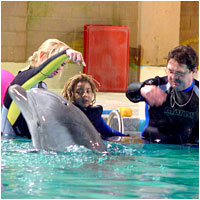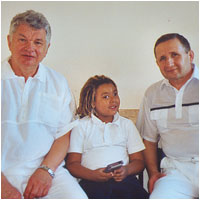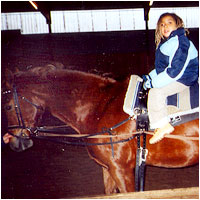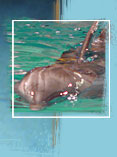 |
 |
 |
Therapies: Overview
Dolphin therapy research project
The dolphin therapy research programme is run by the University of Würzburg under the supervision of PDDr. E. Breitenbach, Dipl.-Psych. and his assistant Ms. E. Stumpf, Dipl.-Psych. The programme is aimed at children aged between 5 and 10 who display significant emotional and contact impairment. In other words whose ability to communicate is seriously impaired. The therapy's goal is to establish communicative contact with the dolphin and so stimulate a basic, simply structured dialogue between the child and its environment. Using scientific methods the study aims to establish whether or not dolphin therapy has a positive effect on handicapped children's development. Therapy sessions take place at leisure park Heidepark Soltau's dolphinarium and last 5 days. Participating children must live within a 100 km radius of the park as they have to commute daily to the park.
Bobath Physiotherapy
The method is based on a holistic concept developed by Dr. Karel and Bertha Bobath and founded on neurophysiological knowledge. It is used for children with impaired motor and sensory development (e.g. asymmetries, delayed development and handicaps). The aim of the therapy is to help the child develop its abilities to the greatest possible extent and to achieve as much independence in everyday life as it can.
The child's posture and movements are manipulated using special holds and the help of acoustic, optical and tactile stimulation. As therapy progresses the amount of assistance is continually reduced until the child finally learns to control its movements by itself.
M. Nathan has 2 half hour sessions a week.
|
|
 |
|
Manual therapy: the intensive neurophysiological rehabilitation system - The Kozijavkin Method:
Unlocking the vertebral column segments results in an improvement in functional conditions both in the horizontal as well as in the vertical planes. The nutritional supply to the organs is enhanced by an improvement in the circulation of the blood.
We encourage this by applying special massages, reflexotherapeutic and physiotherapeutic techniques, so as to consolidate and even to optimize the new functional conditions. The positive effect which is achieved by means of the therapy affects both the treated joints as well as triggering an effect on the entire body with its motoric, sensoric and vegetative nervous system. The objektive is to preserve the newly achieved "physiological" condition and, building on this, to help the patient in achieving physiological motor skills both by means of passive as well as active movement patterns.
M. Nathan has already been 7 times in the Ukraine for treatment by Prof. Dr. Kozijavkin. Every time he has made good progress. Without the treatment he would not be in the condition he is now.

Speech therapy
Is all about recognising the connections to the prelingual area. These include eating, self-copying and copying others. Focused treatment in the prelingual area makes it easier for children to learn active speech.
M. Nathan has 1 half hour session a week.
|
|
 |
|
Hippotherapy
Hippotherapy is an occupational therapy based on neurophysiology and an offshoot of therapeutic horse riding. The multi-dimensional rhythmic vibrations emanating from the horse's back when it moves at “walk” pace (with a frequency of 90 – 110/min) are effective therapeutic elements which benefit the patient. It enables concerted work to improve muscle tone and targeted training of posture and balance.
M. Nathan has 1 20 minute session a week, which is not covered by his health insurance.
Craniosacral therapy
Craniosacral therapy has its roots in the relatively new discovery of a system specific to the human body, also known as the Craniosacral System. It includes the brain and the nerve tracts running along the spine and encased in a fine membrane (the Dura Mater). There is also a liquid (Liquor cerebrospinalis) between the membrane and the nerve cells The brain is also encased in different membranes and this liquid. The surrounding bones: sacrum, spine and skull are further elements of the system.
In healthy people a tangible manifestation of this system is a rhythmic pulse with a frequency of 6-14 cycles / minute. It is completely separate from respitory and circulatory functions and cannot be consciously controlled. With some practice it is possible to feel this rhythm by laying a hand on any part of the body, even through clothes.
The treatment: craniosacral contact makes use of the body's bones and joints as well as the fascia. The therapist uses a very light touch of the hands to identify where tension is located. Absolutely no physical force is employed, at the utmost slight pressure (5 to 10 grams) is applied. This in itself is enough for the body to “gain trust" and relax. The therapist's hands grip the patient's body lightly and so identify tension which is virtually unidentifiable to others. The process seems similar to the laying on of hands but is actually totally different. The therapist continues with gentle movements, which require a lot of time and patience, while waiting for the patient to re-enter their original, relaxed state. Sessions last for approximately half an hour and the therapist decides on an individual basis how often the patient should be treated.
M. Nathan has 1 session a month, which is not covered by his health insurance.
|
|
 |

